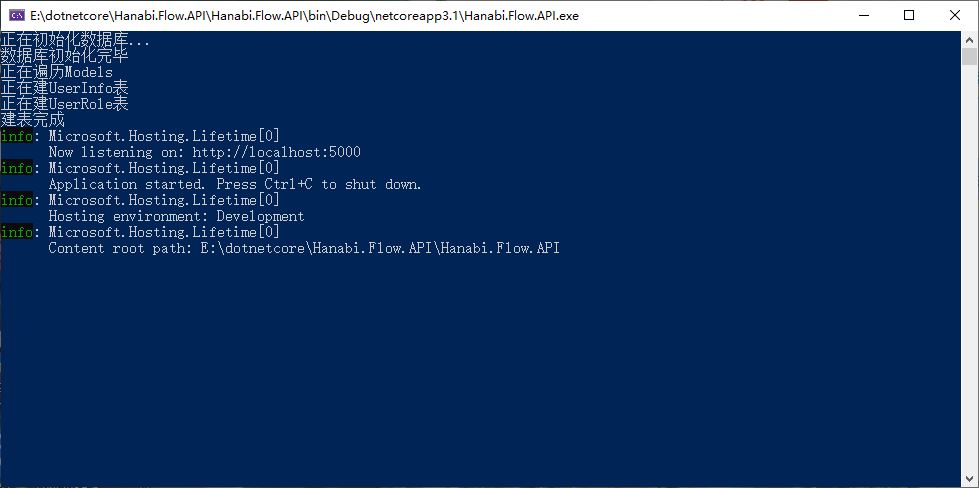.NET Core前后端分离(3) - ORM的选用(SqlSugar) + Code First初始化数据库
经过之前的步骤,已经设置好了配置文件的读取方法,现在让我们来设置ORM,这里我们选用SqlSugar作为本项目的ORM
构建Model层
因为要使用Code First,先在解决方案下新增类库项目Hanabi.Flow.Model,引入ORM包sqlSugarCore,会在这里构建项目的Model层,在其中添加文件RootEntity.cs,内容为
1
2
3
4
5
6
7
8
9
public class RootEntity
{
/// <summary>
/// ID
/// </summary>
[SugarColumn(IsNullable = false, IsPrimaryKey = true, IsIdentity = true)]
public int Id { get; set; }
}
这是所有Models的基类,因为之后的所有Models都会具有Id列,所以它们都会继承这个类
新建类UserRole.cs以及UserInfo.cs,分别作为用户角色类以及用户信息类
这里只写出UserRole.cs的内容,注意详细定义每个字段的SugarColumn特性即可
1
2
3
4
5
6
7
8
9
10
11
12
13
14
15
16
17
18
19
20
21
22
23
24
25
26
27
28
29
30
31
32
33
34
35
36
37
38
39
40
41
42
43
44
45
46
47
/// <summary>
/// 权限ID
/// </summary>
[SugarColumn(IsNullable = false)]
public int RoleId { get; set; }
/// <summary>
/// 角色名称
/// </summary>
[SugarColumn(ColumnDataType = "nvarchar",Length = 20,IsNullable = true)]
public string Name { get; set; }
/// <summary>
/// 角色描述
/// </summary>
[SugarColumn(ColumnDataType = "nvarchar", Length = 50, IsNullable = true)]
public string Description { get; set; }
/// <summary>
/// 创建者ID
/// </summary>
[SugarColumn(IsNullable = true)]
public int? CreateId { get; set; }
/// <summary>
/// 创建时间
/// </summary>
[SugarColumn(IsNullable = false)]
public DateTime? CreateTime { get; set; } = DateTime.Now;
/// <summary>
/// 修改ID
/// </summary>
[SugarColumn(IsNullable = true)]
public int? ModifyId { get; set; }
/// <summary>
/// 修改时间
/// </summary>
[SugarColumn(IsNullable = true)]
public DateTime? ModifyTime { get; set; } = DateTime.Now;
/// <summary>
/// 逻辑删除
/// </summary>
[SugarColumn(IsNullable = true)]
public bool? IsDeleted { get; set; }
定义数据库上下文类
新建Data文件夹, 在这里面新增数据库上下文类MyContext,主要用于建立和数据库之间的连接,以及程序启动时数据库的生成,其中object.ObjToEnum是一个自定义的扩展方法,之后可以在项目中查看具体写了啥
1
2
3
4
5
6
7
8
9
10
11
12
13
14
15
16
17
18
19
20
21
22
23
24
25
26
27
28
29
30
31
32
33
34
35
36
37
38
39
40
41
42
43
44
45
46
47
48
49
50
51
52
53
54
55
56
57
58
59
60
61
62
63
64
65
66
67
68
69
70
71
72
73
74
75
76
77
78
79
80
81
82
83
84
85
86
87
88
89
90
91
92
93
94
95
96
97
98
99
100
101
102
103
104
105
106
107
108
109
110
111
112
113
114
115
116
117
118
119
120
121
122
123
124
125
126
127
128
129
130
131
132
133
using Hanabi.Flow.Common.Helpers;
using SqlSugar;
using System;
using System.Collections.Generic;
using System.Linq;
using System.Reflection;
using System.Text;
namespace Hanabi.Flow.Data
{
public class MyContext
{
private SqlSugarClient _db;
private static string _connectionString;
private static DbType _dbType;
/// <summary>
/// 数据连接对象
/// Blog.Core
/// </summary>
public SqlSugarClient Db
{
get { return _db; }
private set { _db = value; }
}
/// <summary>
/// 连接字符串
/// Blog.Core
/// </summary>
public static string ConnectionString
{
get { return _connectionString; }
set { _connectionString = value; }
}
/// <summary>
/// 数据库类型
/// Blog.Core
/// </summary>
public static DbType DbType
{
get { return _dbType; }
set { _dbType = value; }
}
public MyContext()
{
string connectionString = AppSettings.app("DBSetting", "DBString");
string dbType = AppSettings.app("DBSetting", "DBType");
_connectionString = connectionString;
_dbType = dbType.ObjToEnum<DbType>();
if (string.IsNullOrEmpty(connectionString))
{
throw new ArgumentNullException("数据库连接字符串为空");
}
_db = new SqlSugarClient(new ConnectionConfig()
{
ConnectionString = connectionString,
DbType = _dbType,
IsAutoCloseConnection = true,
InitKeyType = InitKeyType.Attribute,//mark
MoreSettings = new ConnMoreSettings()
{
IsAutoRemoveDataCache = true
}
});
}
public void GeneratorData()
{
Console.WriteLine("正在初始化数据库...");
_db.DbMaintenance.CreateDatabase();
Console.WriteLine("数据库初始化完毕");
Console.WriteLine("正在遍历Models");
var modelTypes = Assembly.GetExecutingAssembly().GetTypes()
.Where(type => type.IsClass && type.Namespace == "Blog.Core.Model.Models")
.Select(type => type)
.ToList();
modelTypes.ForEach(model =>
{
if (!_db.DbMaintenance.IsAnyTable(model.Name))
{
Console.WriteLine($"正在建{model.Name}表");
_db.CodeFirst.InitTables(model);
}
});
Console.WriteLine("建表完成");
}
/// <summary>
/// 功能描述:根据实体类生成数据库表
/// 作 者:Blog.Core
/// </summary>
/// <param name="blnBackupTable">是否备份表</param>
/// <param name="lstEntitys">指定的实体</param>
public void CreateTableByEntity<T>(bool blnBackupTable, params T[] lstEntitys) where T : class, new()
{
Type[] lstTypes = null;
if (lstEntitys != null)
{
lstTypes = new Type[lstEntitys.Length];
for (int i = 0; i < lstEntitys.Length; i++)
{
T t = lstEntitys[i];
lstTypes[i] = typeof(T);
}
}
CreateTableByEntity(blnBackupTable, lstTypes);
}
/// <summary>
/// 功能描述:根据实体类生成数据库表
/// 作 者:Blog.Core
/// </summary>
/// <param name="blnBackupTable">是否备份表</param>
/// <param name="lstEntitys">指定的实体</param>
public void CreateTableByEntity(bool blnBackupTable, params Type[] lstEntitys)
{
if (blnBackupTable)
{
_db.CodeFirst.BackupTable().InitTables(lstEntitys); //change entity backupTable
}
else
{
_db.CodeFirst.InitTables(lstEntitys);
}
}
}
}
接着我们在Startup中将其注册到服务
* services.AddScoped
接着在Hanabi.Flow.API项目中添加文件夹Extensions,添加文件DataGenerator.cs,在这里调用MyContext里的方法,实现启动时生成数据库
1
2
3
4
public static void UseDataGenerator(this IApplicationBuilder app, MyContext myContext)
{
myContext.GeneratorData();
}
最后,在Startup.cs文件的Configure函数使用短路中间件(UseEndpoints)的后面使用这个新添加的中间件
1
app.UseDataGenerator(myContext);
启动程序,发现数据库已经在启动时被正确初始化了:
连接数据库查看,确实已经生成了库和表,至此,利用SqlSugar作为ORM,并实现Code First就完成了
本文由作者按照 CC BY 4.0 进行授权

